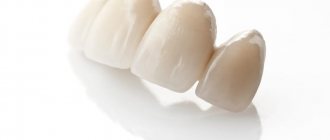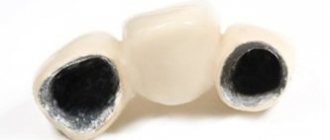Chief editor of the site:
Snitkovsky Arkady Alexandrovich
Chief physician of the professorial dentistry “22 Century”, dentist, orthopedic dentist
Author of the article:
Scientific team of dentistry “22 Century”
Dentists, candidates and doctors of medical sciences, professors
At a fairly affordable price, a metal-ceramic crown can provide normal chewing and has a very aesthetic appearance
Installing metal-ceramic dental crowns is one of the most affordable and effective ways to restore damaged teeth. At a fairly affordable price, a metal-ceramic crown can provide normal chewing and has a very aesthetic appearance.
High-quality dental prosthetics using metal-ceramic crowns depends on three factors: the high quality of the materials used, the use of modern equipment , and the experience and professionalism of specialists. Our clinic pays great attention to all these points.
What is metal ceramics?
The term “ metal-ceramics ” refers to a special type of dentures and their manufacturing processes. The main idea is that a metal base is made, onto which a ceramic coating is applied. Thanks to modern materials, the crown is very strong and durable . It can be given any color that will fully match the color of the rest of the teeth.
The following can be made from metal ceramics:
- Crowns;
- Bridge prostheses (“bridges”);
- The supragingival part of the implant, when metal ceramics are attached to a special base - an abutment.
Types of crowns
- Half-crowns (covers 3 of 4 surfaces of the tooth; the surface facing the cheek or lip remains free; used for restoration purposes or for fixing a bridge);
- Full (completely hides the natural crown);
- Crowns with a pin (installed when a tooth is more than half destroyed; the pin is inserted into the root canal and secured);
- Equator crowns (used for splinting; made of metal and installed in a strip around the tooth);
- Telescopic crowns (the dentist adjusts the height of such a crown directly on the tooth);
- Stump (suitable for restoration of a completely destroyed natural crown).
The advantages of metal-ceramic dental crowns are obvious
A metal-ceramic crown can replace any tooth.
- Artificial metal-ceramic dentures ensure normal chewing of food, and in appearance and color they are no different from other teeth;
- Using a metal-ceramic crown, you can replace any tooth: an incisor, for which aesthetics is primarily important, or a molar, which must have sufficient strength;
- At a relatively low cost, a metal-ceramic crown is durable: it can last up to 10 – 15 years.
Indications and contraindications
Fixed option of prosthetics with crowns is a popular dental service. Crowns allow you to restore the appearance of the tooth and use it for chewing without any problems. Depending on the location of the defect and the financial capabilities of the patient, crowns can be placed on teeth in Moscow from various materials.
Prosthetics with crowns is used in the following clinical cases:
- With pathological abrasion of tooth enamel
- If necessary, restore the anatomical shape of the part of the tooth destroyed by the crown
- If you need to reliably protect a root filling
- If the patient is not satisfied with the appearance of the tooth
- To strengthen the tooth
Contraindications for installing dental crowns
There are situations when it is impossible to put a crown on a tooth, either in principle or temporarily. Main contraindications to prosthetics:
- Inflammatory processes in the oral cavity
- A tooth in need of restoration is loose due to periodontal disease.
- Exacerbation of chronic diseases
- Allergy to anesthesia (installation of a crown requires nerve depulpation and canal filling)
- Other conditions that are contraindications to surgical procedures
It is important to understand that a crown is an orthopedic structure for a tooth that is available, but does not suit the patient in terms of physical or external parameters. If a tooth is removed or completely destroyed, it cannot be replaced with a crown, and bridge prosthetics on abutment teeth or implantation are considered as an alternative.
An absolute contraindication to prosthetics are conditions that are the basis for any other surgical intervention. Also, prosthetics are postponed if acute inflammatory processes in the oral cavity, diseases of the bone tissue of the jaw and some diseases in the acute stage are diagnosed.
Why should you contact the 22nd Century Clinic?
The quality and cost of a metal-ceramic crown may vary in different clinics.
The quality and cost of a metal-ceramic crown may vary in different clinics. If the prosthesis is made of high-quality modern materials , then it can really be the best way to restore a lost tooth. If outdated materials and equipment are used, then cermets are unlikely to be a full-fledged replacement; they will quickly collapse.
At the “22 Century” clinic you can install high-quality, durable dentures:
- Professors and researchers with a high level of professionalism and extensive experience work for you;
- We use modern metal alloys and durable porcelain coatings;
- The clinic’s equipment allows us to produce precise metal frames that completely match the shape of the destroyed tooth.
Thanks to this, we have numerous positive reviews from our patients.
How to remove crowns from teeth
Today, the prosthesis can be removed in different ways: sawing with a drill, removal using ultrasound, a Kopp apparatus or Coronaflex is used. Each type can be briefly described as follows:
- Sawing. An outdated but effective method, which has a significant disadvantage - after it the design is no longer suitable for use.
- Kopp apparatus. The dentist grinds off the cement at the base of the prosthesis, then picks up the edge with a hook-shaped instrument, presses the release button of the device, carefully removing the dental crowns. If everything is done efficiently, the structure remains unharmed and can be reinstalled.
- Ultrasound. The optimal way to remove old prosthetic materials: ultrasound breaks even glass ionomer cement.
- "Coronaflex". A pressurized air stream is applied to the cement, destroying it. The price of the procedure is higher, but is justified by its effectiveness and complete safety for crowns.
Crown removal at Dentalis is quick and painless. If the denture remains usable, we will carefully remove it and keep it intact. The dental clinic in Troitsk is located at the address: st. Central, building 15, 3rd floor. Schedule a consultation with an orthopedist and make an appointment at any convenient time by calling.
Some more interesting facts: how are metal-ceramic crowns created?
First, the doctor makes an impression of the patient’s teeth.
The process of creating metal-ceramic crowns is a very delicate, almost jewelry-like work:
- First, the doctor makes an impression of the patient's teeth;
- Based on the impression, a shape and metal crowns are created that completely match the shape of the teeth;
- The most difficult part of the work is applying a layer of porcelain to the metal base.
Thanks to the painstaking work of our specialists, metal-ceramic dentures are strong, durable, and provide a beautiful smile to our patients.
Come to the “22nd Century” clinic: we will be happy to provide you with quality services!
Date of publication: September 20, 2020 Last update: September 22, 2021 © 2020 Professorial Dentistry “22 Century”. All rights reserved.
Dental crowns at Amazing Price Dentistry
Installation of a crown at Amazing Price Dentistry is carried out after filling the root canals and grinding down the tooth to the thickness of the future crown. After these preparatory manipulations, an impression is taken from the corresponding areas of the jaws, according to which a crown is made in a dental laboratory.
Each case of prosthetics is individual, so during the consultation the dentist will explain all the necessary details of the process.
| Name | Price, rub.) | Additional Information |
| Metal-ceramic crown | 2950/3950/4950 | Made in Germany, Japan |
| Zirconium crown (metal-free ceramics) | 13500 | Made in Germany |
Indications
Dental prosthetics using crowns is carried out in cases where tooth damage excludes the possibility of filling it. Crowns are necessary to restore the chewing function of a tooth and its appearance. The most common crown materials are metal alloys, plastics, ceramics, zirconia and porcelain.
Crown removal may be necessary for a number of reasons. Among them:
- Destruction of the cement of the crown. The reason for this may be the quality of the cement or excessive loads on the prosthesis.
- Pain arising under the crown. Pathological processes occurring in a prosthetic tooth can be a consequence of poor-quality prosthetics or serious diseases.
- Prosthetics of adjacent teeth. When a tooth adjacent to the crown is destroyed, the technique of “bridge” prosthetics is most often used, when instead of two separate crowns, a special structure is installed - a “bridge”. This design contains several dentures and is attached to healthy teeth on both sides.
- Severe crown wear. When the material wears off, the prosthesis loses its functional properties and can injure surrounding tissues and neighboring teeth. The reason for this may be the poor quality of the crown material or problems during its installation.
Crown removal process
If it is possible to treat a tooth under a crown without removing it, the doctor can make holes in the prosthesis through which manipulations are carried out on the tooth. After treatment is completed, the holes are filled.
If it is necessary to completely remove the crown, there are two methods for carrying out this procedure - sawing and removal with a Kopp apparatus.
Sawing is a method of removing a prosthesis in which the crown is destroyed using a special drill. The risk of damage to the tooth under the crown with this method is minimal. The cost of this procedure is much lower, but subsequently it will be necessary to manufacture and install a new crown, which incurs additional costs for the patient.
Removal of the crown using the Kopp apparatus is performed without destroying the prosthesis. To do this, an ultrasonic device is used to destroy the cement base of the crown, after which a special device is put on the prosthesis, which moves the crown to the side with small pushes. After this, the entire crown is removed from the tooth. This method requires the professionalism of a specialist and good equipment, and therefore has a high cost of the procedure. If this procedure is not carried out correctly, complications may arise - chipping of the crown, destruction or fracture of the tooth root.
After the crown has been removed, it is necessary to immediately continue treatment of the problem, and then re-prosthetize the tooth. The exposed root of the tooth from which the crown has been removed is very sensitive and needs protection, so during long-term treatment it must be covered with a temporary prosthesis.









